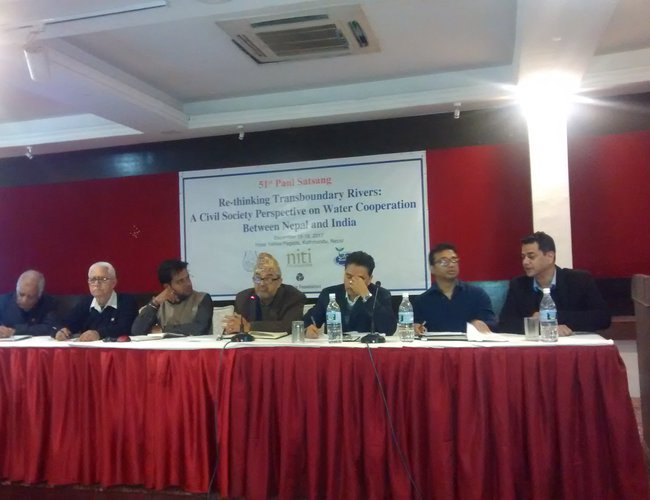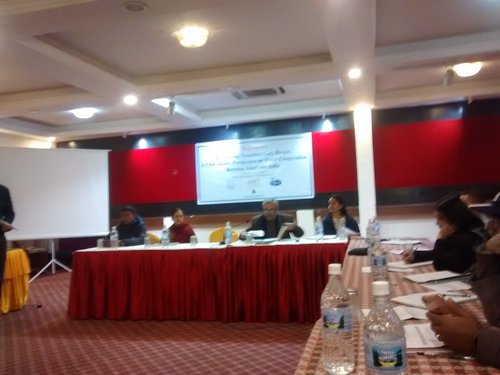
Whether it is a bilateral meeting or a national level discourse on water between Nepal and India, all debates focus on the issue of major rivers like Gandaki, Kosi, Karnali or Mahakali and all are at the formal level.
All perspectives are based on national broader interest, which includes security and diplomacy. Even if technicians agree on certain issues and agenda, security and diplomacy stand as the stumbling blocks to stop the proceedings. This is what Nepal has seen in the last seven decades of Nepal-India water sharing drama.
Although Nepal and India have signed several agreements on major rivers like Gandaki, Kosi or Mahakali, these treaties generated more distrust. Nepal and India share not only these major rivers, but also the more than 6000 rivers and streams flowing from north to south. Whenever problems and challenges arise, the disputes are settled at the community and local level.
Although all these rivers are marginalized with no voice at all for their use and disputes settled by marginalized communities and local level, the good things about them is that they work perfectly and without any misunderstanding. Local people and communities living in both sides of the border between Nepal and India share the benefits and miseries together.
This is the reason they have developed effective mechanisms for early warning system. When people living upstream see the water level rising, the community relays it to downstream community. This is the reason even during the floods, these rivers create less harm than the big ones.
However, these rivers are marginalized at the national level. This year Khada River, west Rapti and Rapti and other smaller streams were responsible to create havoc, the blame went wrongly to the big rivers like Kosi or Karnali or Gandaki.
Given the state of river management, water experts and community leaders from Nepal and India discussed efficient management of these marginalized rivers.
Organized by Nepal Water Conservation Foundation and Niti Foundation, with the support from The Asia Foundation, India, the two day discourse drew the attention that marginalized community managed marginalized rivers do have less disputes than rivers managed at the national level.
“We have been talking about the river management for almost 70 years. We are unable to find an amicable way for sharing the benefits,” said Madhav Belbase, joint secretary of Water and Energy Commission. “Technically, there is nothing to find. When diplomacy comes, it stalls forever,” said Belbase, who participated in a number of Nepal-India water sharing negotiations.
The experts argue that the marginalized rivers managed by the marginalized communities shows the community sensitivity and decent water management system, without any controversy. Thus marginalized rivers should be given to the marginalized communities, the argument goes.
“The problem with the water sharing negotiations is linked with security. Good news is that it is gradually weakening,” said Sagar Prasai, country director of The Asia Foundation India.
If small and marginalized rivers are solely given to marginalized communities and marginalized local levels, everything is possible there. The study conducted on West Rapti River under a Rapti Trans-boundary Initiative (RAP.TI) showed that two governments failed to agree on Naumure for benefit sharing. However, communities from both the countries did have successful modalities.
At a time when no national level intervention and initiative is able to bring any tangible result and settle the disputes, this small initiative started by civil society and community from Nepal and India shows a way out.
“When benefits are shared on the basis of equity, there is no question of raising the dispute. Communities have more effective ways,” said Dr. Dwarikanath Dhungel, former water resources secretary and member of study team.
From the Naumure, the source of West Rapti, up to India reaching to Gorakhpur, West Rapti creates havoc during the rainy season along its way. However, communities have to face the crisis of water during the dry season.
People and communities at the both the sides are peacefully managing their conflict. “The lesson learnt during the study will provide much necessary materials to sort out several other trans-boundary marginalized rivers along the India Nepal border,” said Abinash Mohanty, Asian Development Research Center.
Participated by Gorakhpur
Environmental Action Group, Pachsheel Development Trust, Pragana Farmer Managed
Irrigation System and Indian Environment Law Organization from Indian side and
Nepal Water Conservation Foundation, Niti Foundation and community water users
from Rolpa and Dang, the event brought a variety of views to come closer on the
issue.
At the function moderated by Nirjan Rai of Policy Entrepreneurs Inc, experts from India and Nepal discussed at length the community engagement in West Rapti.
At a time when national level initiatives have been unable to bring any solution, the initiatives taken at the community level are more effective and manageable.
“The national governments have many interests. They only pursue engineering intervention, including building barrage and embankment to contain the rivers. However, the community finds the solution while living with rivers and sharing benefits,” said Dr. DK. Mishara, Barh Mukti Abhiyan. “You cannot control the floods by building the embankments. Had Kosi and Bagmati embankments saved the people, Indian citizens living in the areas would not face the consequences of flood. Communities have a way out to amicably manage the river sharing the benefits.”
Moderating the session on rethinking discourse on water benefit sharing, Chairman of Nepal Water Conservation Foundation, academician and former water resource minister Dipak Gyawali said that the management part of the marginalized rivers should be given to marginalized community and local level. “These community and local level institutions know how to manage the rivers and share the benefits well.”
As sharing the information among the community members from across the border on flood helped save many lives during the flood last year, this also showed the effectiveness and importance of community management and engagement.
“There are many instances in west-Rapti river basin where communities from the both the countries are working closely in sharing the benefits,” said Dr. Bijaya Singh, Gorakhpur Environmental Action Group.
Shawahiq Siddiqui from Indian Environmental Law Organization highlighted a case study of Pandai river that marks the international border for a short stretch between the Chitwan National Park in Nepal and the Valmiki Tiger Reserve in India where communities have found a long lasting formula to share the water. “Although this dispute is near the border between the two countries, local level institutions and communities have proposed the way out, which has been functioning well.”
At a time when disputes involve the national governments over the issue of benefit sharing, RAP-TI has shown the way out. “Our studies have shown that there is the need to have more community level engagement,” said Govinda Pokharel, vice chair Nepal Water Conservation Foundation.
Closing the program Mohan Das Manandhar of Niti Foundation stressed the need to have more interactions at the community and civil society levels on the water sharing issue.
Although the small rivers are marginalized and managed by marginalized communities, benefit sharing as the best river management modality is only possible if there are communities and local level institutions involved in it.

Keshab Poudel
Poudel is the editor of New Spotlight Magazine.
- IWMI: SoLAR Global Science-Policy Forum Conference
- Apr 25, 2024
- CLA: Samriddhi For Skill Development
- Apr 23, 2024
- ECONOMY: Growth At 3.3
- Apr 16, 2024
- DPM’s SHRESTHA’S CHINA VISIT High Profile, Low Key
- Apr 14, 2024
- Maha Kumbha In Barahkshetra: A Sacred Festival In Sacred Koshi (Kaushiki) River
- Apr 09, 2024
















